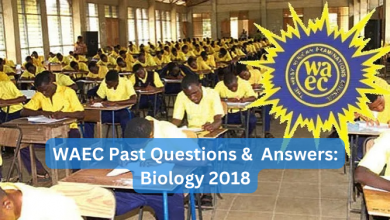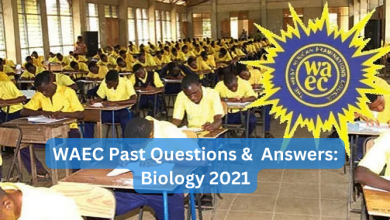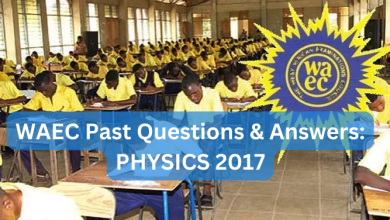WAEC Past Questions & Answers: BIOLOGY 2019

Welcome to our WEAC past question and answer series. In this post, we will be sharing ‘recent’ past questions and their answers for various subjects. Stay tuned enjoy while learning.
1. Plants which can survive in extremely dry places are called….
A Mesophytes
B Xerophytes
C Hydrophytes
D Angiosperms
2. The presence of ______ for swimming in a tad-pole enables it to adapt in an aquatic habitat.
A Gills
B Swim bladder
C Tail
D Fins
3. Possession of thin membrane enables a tapeworm to
A Fasten themselves to the wall of the host’s intestine
B Lay numerous eggs
C Absorb digested food from the host’s intestine to their system
D Shield themselves inside the host’s intestine with anti-enzymes in order to avoid being digested
4. Which of the following juices contains the enzyme ptyalin?
A Gastric juice
B Succus
C Pancreatic juice
D Saliva
5. Which of the following essential substance is contained in vegetable?
A Chlorophyll
B Glucose
C Mineral Salts
D Carbon dioxide
6. Good quality food will perform the following functions in human except
A Supplying energy
B Providing resistance against malaria
C Maintaining health
D Sustaining growth
7. Which of the following is considered to be the first product of Photosynthesis?
A Protein
B Starch
C Energised Chlorophyll
D Hydroxyl ions
8. Which of the blood corpusles are irregular and amoeloid in shape
A Leucocytes
B Erythrocytes
C Thrombocytes
D Plasma
9. Which organ removes the largest quantity of water from the blood?
A Lung
B Skin
C Kidney
D Intestine
10. The movement of blood between the heart and all other parts of the body beside the lungs is
A Double circulatory system
B Pulmonary system
C Single circulation
D Systemic circulation
11. The change in the genetic make up of an organism resulting in an inheritable characteristics which is new is
A Mutation
B Locus
C Hybrid
D Diploid
12. The organic molecule(s) present in the nucleus is/are
A DNA
B Protein, DNA, RNA
C ATP and RNA
D RNA
13. Albinism is an expression of trait controlled by
A Chromosomes
B Recessive genes
C Dominant genes
D Mutation
14. The male sex cells also called gametes are produced in the testes by a process called
A Gametogenesis
B Implantation
C Spermatogenesis
D Spermatozoa
15. Which of the following describes an example of fertilisation in higher organisms
A Fusion of sperm and egg nuclei
B Pollen grain landing on a sticky stigma
C Ejaculation of the egg and pollen grain
D Ejaculation of sperm into the female body
16. 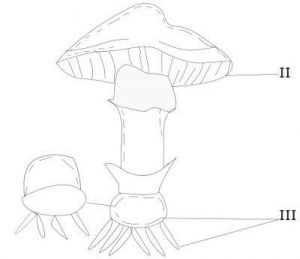
The part labeled III in the above diagram is
A Root
B Gills
C Hyphae
D Rhizoids
17. 
The organism shown can be found in
A Arid land
B Secluded environments
C Aquatic habitation
D Moist environments
18. The possession of chloroplast in Euglena virids enables it to
A Store starch
B Carry out photosynthesis
C Reproduce
D Respond to light
19. Viruses are pathogens of the following diseases except
A Tuberculosis
B Measles
C Small pox
D Poliomyelitis
20. The association between two organisms living together in which only one benefits from the association while the other is neither benefited nor harmed is
A Predation
B Competition
C Commensalism
D Dispersal
21. Which of the following will have the least effect on the rate of change of the numbers in a population
A Mutation
B Food Supply
C Disease
D Predation
22. Which of the following controls all voluntary actions
A Olfactory lobes
B Cerebrum
C Hypothalamus
D Pons varolii
23. Which of the following statement describes an autonomic nervous system
A It always stimulates effectors
B Activities are voluntary
C It dials with external stimuli and their responses
D It affects glands, cardia muscles and smooth muscles
24. The glomerular filtrate contains the following except
A Water
B Urea
C Blood Corpuscles
D Glucose
25. One of the following is not the theory of natural selection stated by Charles Darwin
A Characteristics acquired through use or disuse are transmitted offspring
B Variations appear by themselves in a population
C Heredity variations are transmitted to offspring
D Species that are the fittest for the environment contribute more offsprings to the next needs of the generation
26. Ecology is best defined as the study of
A The characteristics of an environment
B The inter-relationship between living organisms and the environment
C Living organisms in a particular area
D The habitats and wild life
27. The following processes are involved during expiration in man except
A The inter costal muscles relax
B The thoracic activity first increases in volume
C The sternum moves inward
D The ribs are moved downwards and inwards
28. Which of the following is an example of continuous variation?
A Human blood groups
B Sex difference in human
C Haemoglobin types
D Height in humans
29. One of the following is an effect of clay soil on vegetation
A Supports luxuriant vegetation such as forest
B Supports scanty vegetation
C Does not support light vegetation
D Support arid vegetation
30.Which of the following factors is not considered in a terrestrial habitat?
A Temperature
B Sunlight
C Humidity
D Turbidity
31. What type of vertebrate assists in breathing alongside with the ribs?
A Sacral
B Caudal
C Thoracic
D Lumber
32. Which of the following statement is correct about Southern Guinea Savanna in Nigeria
A It is the largest of all the biotic community in Nigeria
B It has plants species like Iroko, Opepe etc
C It has plants species like Iroko, Opepe etc
D It has no trees
33. In an ecosystem, the organism which changes light energy into stored chemical energy is the
A Consumer
B Producer
C Decomposer
D Carnivore
34. In the theory of use and disuse Lamarck proposed that evolution occurred because of the following except
A There is natural selection of offspring
B There is great changes in the environment
C Organism develop specialised characters
D The characters are inheritable
35. Which of the following is a behavioural adaptation that protects prey from predators?
A Hibernation
B Shedding of leaves
C Secreting irritating fluid
D Dormancy
36. The period of inactivity seen in some animals during long period of heat or drought is
A Migration
B Aestivation
C Hibernation
D Adaptation
37. The insect trapping movements of the leaves of the venus fly trap is a behavioural adaptation for
A support
B surviving adverse weather conditions
C obtaining food
D dormancy
38. Animals are said to gregarious when
A they survive adverse conditions of cold weather
B they transmit information from one individual to another
C they are of the same species moving together in a group
D they give an alarm to alert others to show the normal protective behaviour of the group when danger threatens
39. The type of nutrition shown by spirogyra is
A Symbiosis
B Holozoic
C Chemosynthetic
D Holophytic
40. The type of nutrition shown by spirogyra is
A Symbiosis
B Holozoic
C Chemosynthetic
D Holophytic
41. Which of the following pairs of organisms are photosynthetic?
A Amoeba and paramecium
B Euglena and chlamydomonas
C Volvox and Rhizopus
D Nostoc and plasmodium
42. The type of nutrition in which two organisms of different species live together and derive nutrients from each other is
A symbiotic nutrition
B saprophytic nutrition
C holozoic nutrition
D holophytic nutrition
43. Which of the following statement about the similarities in plant and animal transport is correct?
A Materials and hormones are transported in fluid form
B The transport medium is made up of only tissues
C Their materials are transported in the same vessels
D Diffusion is not required
44. Which of the following describes the function of lymph
A Temperature regulation
B Production of antibodies
C Engulfing
D Body defence
45. Which of the following describes the function of lymph
A Temperature regulation
B Production of antibodies
C Engulfing
D Body defence
46. Which of the following is not a transmittable character in plants
A Habit of growth
B Resistance to environmental factors
C Life span
D Haemophilia
47. Inheritable character/features possessed by an organism can be referred to as
A Genes
B Locus
C Traits
D Allelo morphs
48. One of the following is a process of transmission of hereditary characteristics by chromosomes
A Genes relating to the same character occupy identical locations on the chromosomes
B Separation of homologous chromosomes into four daughter cells
C Separation of gametes during fertilisation
D Dictating the formation of a protein by a gene in a chromosome
49. The attachment of the embryo to the wall of the uterus is called
A Ovulation
B Implantation
C Gametogenesis
D Placentation
50. Which of the reproductive system in mammals secretes a part of the seminal fluid which raises the pH of the fluid in the female reproductive system?
A Cowper’s gland
B Prostate gland
C Vas deferens
D Seminal Vesicle
51. 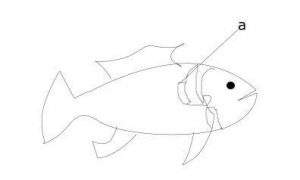
The part labelled a in the above diagram is used for
A Detection of pressure in water
B Maintaining buoyancy in water
C Gaseous exchange
D Movement in water
52. 
The above organism can be classified under which phylum in the animal kingdom
A Nematoda
B Chordata
C Porifera
D Annelida
53. One important characteristics of green plant is that they
A possess specialised sense organs
B Are usually motile
C Are auto-tropic
D Respond slowly to stimuli
54. A virus can sometimes be regarded as a living organism because it
A causes diseases in plants and animals
B It exists in a variety of shapes
C Is easily visible with the aid of an electron microscope
D Reproduces in living cells
55. A population is best described as
A A group of the same species of organisms living together
B A group of animals and plants living together
C A group of insects and grasses
D Different species of wild animals
56. The number of times an organism occurs within a given area of a habitat is referred to as
A Population growth rate
B Population frequency
C Population growth rate
D Population density
57. Reading the verdict of a case by a magistrate is an example of
A A reflex action
B An instinct
C A conditioned reflex
D A voluntary action
58. Which of the following structures controls the activities of the living cell?
A Nucleus
B Centrosome
C Mitochondrion
D Golgi body
59. Which of the following are components of glomerular filtrate?
A All the components of blood except mineral salts
B Water and salt only
C All the components of blood except plasma protein and cells
D Blood cells, amino acid, salts and nitrogenous wastes
60. The sum total of adaptive changes from pre-existing form that have taken place over a long time resulting in diversity of forms, structures and functions among organism is referred to as…
A Specification
B Inorganic Evolution
C Evolution
D Organic Evolution
Answers To Questions
- B
- C
- C
- D
- C
- B
- B
- A
- C
- D
- A
- A
- B
- C
- D
- C
- D
- B
- A
- C
- A
- B
- D
- C
- A
- B
- B
- D
- A
- D
- C
- A
- B
- A
- C
- B
- C
- C
- D
- B
- B
- A
- A
- D
- B
- D
- C
- D
- B
- A
- C
- B
- C
- D
- A
- B
- D
- A
- C
- D


